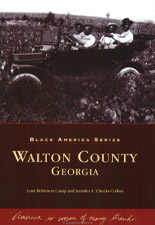Book Review
Walton County Georgia
By Lynn Robinson Camp and Jennifer E. Cheeks-Collins. Black America Series, Charleston, SC: Arcadia Publishing, 2003; 128 pp., photographs, bibliography, notes, index; paper $19.99.
 |
As a sign of growing interest and pride in local and ethnic histories, Walton County Georgia makes a major contribution towards filling the gap in the dearth of recorded African-American history in Walton County archives and libraries. Jennifer Cheeks-Collins is the author of two previous volumes in Arcadia Publishing's Black America Series. Co-author, Lynn Robinson Camp, a native daughter of the region, began planning a pictorial documentation of her hometown at an early age. Her personal ties to the area and sense of place lend an engaging authenticity to the book. The authors relied on a rich mixture of biographies, church histories, newspaper articles, obituaries, notes, resumes, souvenir booklets, and "verbal lore" for background. In the end, oral history combines with an impressive collection of photographs to create a homespun perspective on African-American life in the county.
Through their particular prisms, local histories illuminate much larger historical themes, and Walton County Georgia is no exception. With chapters arranged by subject, such as Church and Religion: Keeping the Faith, The Civil Rights Era: Remembering the Struggle, Business and Economy: Owning Our Own, and Everyday People, the book is a vibrant testament to the complex fabric of the lives of African-American families in small southern towns from the postslavery era to the present.
Although other recent local visual and oral histories, such as Memphis in Black and White and Prince George's County Maryland, include stronger historical narratives, Walton County Georgia is accessible and a pleasure to read, and compares favorably with any of its ilk. The book is certainly on par with Cheeks-Collins' previous books, Gwinnett County Georgia and Madison County Mississippi. This book is equally comparable to the pictorial history of a colorful and distinct Appalachian area of northeast Georgia, Union County Georgia, authored by the Union County Historical Society.(1)
Certain events, especially those that shock and horrify, overshadow other realities in the story of a community. Walton County has long endured the aftermath of a brutal lynching in 1946. Two young black couples, George and May Murray Dorsey and Roger and Dorothy Dorsey Malcom (reportedly 7 months pregnant), were beaten and shot hundreds of times in broad daylight by a mob of unmasked men. The local white power structure successfully kept the perpetrators from being brought to justice, and the case remains unsolved. However, the case fueled civil rights activism all over the country. National media attention was instrumental in President Truman's commitment to civil rights legislation and the racial integration of the United States armed services. Yet, in defiance of the county's lingering stereotypical legacy of violence and racial hostility, Walton County Georgia is a celebration of the region's heritage. Devoting a short chapter in homage to those who lost their lives, the pages balance anguish with joy.
The strength of the book is its well-rounded portrayal of community spirit. Regional appeal is undeniable, yet a broader audience might be reached if the authors had made more of a connection relating local events to universal currents in United States history, such as the violence and barriers faced by African Americans in the South during Reconstruction, or the dashed hopes of black veterans upon returning from patriotic and courageous service in World War II. In the chapter titled "Education: Black Schools and Their Legacy," nothing is mentioned of the monumental confrontation during the years of school integration, or of the racial backlash that followed the 1954 Brown v. Board decision.
The book is a useful model for those in the cultural resources field searching for ways to include the many histories of a particular region in a truly representative interpretation. Certainly in the case of Walton County Georgia, a broader local audience will be reached than a traditional written history of the region allows. Most importantly, Walton County Georgia empowers the African-American community to write its own history, from its unique perspective. The photographs catalog the joy of weddings, social events, graduations, and proud young veterans returning from service, as well as the struggle of those battling for civil rights. Pain and sadness are represented in the pages, yet the reader closes the book with an overwhelming sense of the fortitude of people in their daily lives, complete with disappointments and failures, but who triumph over the obstacles. And it is generally the "everyday people" who make lasting changes. Walton County Georgia is a chronicle of the endurance, achievement, and enjoyment of life of African Americans in rural Georgia, and a welcome addition to the archives of local history.
Mary Anne Hamblen
McDaniel-Tichenor House Museum
Note
1. Beverly Bond and Janaan Sherman, Memphis in Black and White (Charleston, SC: Arcadia Publishing, 2003); Carolyn Corpening Rowe, Jane Taylor Thomas, and Beverly Babin Woods, Prince George's County Maryland (Charleston, SC: Arcadia Publishing, 2003); Jennifer Cheeks-Collins, Gwinnett County Georgia (Charleston, SC: Arcadia Publishing, 2002) and Madison County Mississippi (Charleston, SC: Arcadia Publishing, 2002).
